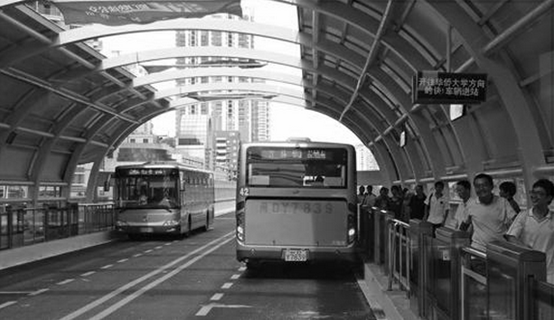The passenger volume continues to reduce while urban transport needs transition
2018.06.14
Oral Account by Yang Tao and Luo Hang, Nanjing Institute of City & Transport Planning Co., Ltd.

BRT has become an important choice for people with its independent lanes and signal priority. [Photo by Gong Renzhi/ China Transport News]
The Ministry of Transport recently released the Transport Sector Development Statistical Bulletin 2017 (Statistical Bulletin for short). The Bulletin shows that the total passenger capacity in 2017 was 127.2 billion in all cities around the country, 1% lower than in 2016. Of this, passenger volumes for buses and trolley buses suffered a year-on-year decrease of 3%, marking the 3rd time for a capacity decrease for regular public transportation, from 78.1 billion people in 2014 to 72.2 billion in 2017.
The continuous decline in urban public transport, is against the strategic direction of public transport development and the target of establishing "Transit Metropolis". It is also inconsistent with people’s expectation for the development of public transport in various cities. It cannot meet people's desire to continuously improve public transport service capabilities and levels amid the increasing congestion of urban transport. To reverse this situation, the transformation and development of urban transportation is very urgent.
Urban transport is too car-oriented Improper allocation of resources
The low cost of owning, using and parking cars, has contributed to the continuous increase of car ownership and high frequency use. Road construction and congestion management both take the smooth operation of cars as their target. Substantial investment of bus priority is not enough and lacks impetus; City development lacks guidance of TOD concept and strategy. Equalization, big block and high-configuration cars expand.
Car-oriented urban transport development concept and unbalanced city development made buses inferior in competition with cars.
The high-speed increase of car ownership and the inadequate involvement of buses made the city development fall into the mire of “more treatments, and more congestion”, causing the continuous reduction of bus passenger flows. Urban transportation will face more fierce challenges if it does not transform its development modes.
Under the car-oriented transport development mode, time and space is not properly allocated. On the one hand, the urban road network does not have a sound and reasonable structure. “A small block road network” to support bus networks has not been formed yet. A road network construction mode that “emphasizes trunk roads and neglects branch roads” leads to problems such as not enough bus routes, not enough stops and high corridor repetitive ratio.
On the other hand, there is a mis-match of road rights for cars and buses, making bus operations difficult to be punctual. A bus-oriented road resource allocation still does not exist. Discontinuous bus lanes, lack of road nets, and signal priority guarantees has led to slow operations on bus lanes and long delays. Time consumption by bus is 1.5 times to twice that of cars or even higher. Travelling by bus lacks enough competitiveness and appeal.
Improper road networks for buses Service model in need of innovation
The continuous decrease of urban bus passenger traffic has a lot to do with the improper road network structure, institutions and mechanisms which lack innovation.
So far, the route setting for urban buses has become homogenized, lacks branch buses or customized buses that can meet the needs of wide coverage, high density and flexible dispatching. Major and medium sized cities should promote a backbone of public transport with big or medium sized passenger traffic such as rail transit and BRT, while encouraging and promoting a new model of internet + public transport. The cities should constantly optimize their regular road networks. This optimization will not be accomplished in one action. Based on a deep understanding of the characteristics of bus passenger traffic distribution, the cities should pay attention to history and continuity, and make minor and progressive dynamic adjustments.
When conceiving route settings, the cities should pay attention to a sound public transit hub system and layout, avoiding too much time taken up by transfers and improving the efficiency of the road network. Road network improvement projects should be promoted in a safe and steady manner during operation.
In addition to improper function settings, improper operational organization is another key problem that hides a good optimization of the road network. The structure of the bus network, not an abundant model of vehicles, not a sufficient smart bus system, not enough system data to support government decisions, not enough dynamic adjustment for bus operation dispatching, all limit better services offered by buses.
In addition, operational companies generally lack endogenetic impetus. Government procurement of bus services is still equal to fiscal expenditure. The operational system and subsidies check, inspection and evaluation system all lack systemic and strategic consideration, making it hard for the bus resources to be used in an effective way.
The bus service model also lacks innovation. So far, urban buses adopt a single fare system. The service concept has not changed from “Bus for the public” to “Bus for All”. A lack of marketing concept and market mechanisms leads to buses which fail to offer a quality, diverse and individualized supply service. Against the background of a shared transport development, developing responsive services and customized bus services for different people, at different times, for different purposes, needs a breakthrough.



